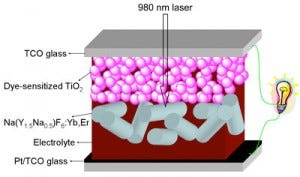Researchers Develop Photovoltaic Cells that Could Power Future Nanorobots
December 14, 2009

photovoltaic-cell
Schematic diagram of a photovoltaic cell driven by a 980-nm laser.
With the development of bionanotechnologies, scientists look forward to the day when nanorobots will be used for in situ and real-time in vivo diagnosis of specific targets and therapeutic intervention. A prerequisite for designing and constructing wireless biological nanorobots is the availability of an electrical source that can function inside the body.According to Nanowerk, researchers in China and Germany have now developed 980-nm laser-driven photovoltaic cells that can provide sufficient power output to drive nanorobots. The cells use rare-earth upconverting nanophosphors to absorb 980-nm laser light and emit visible luminescence, which can excite traditional solar cells to produce electricity. Because biological tissue is highly transparent to 980-nm light, these devices will function even when they are covered by a layer of thick tissue."It is well known that near-infrared light in the wavelength range of 700 to 1000 nm is absorbed less by biological tissues; the typical penetration depth of 980-nm light can be several centimeters in biological tissue," explains Zhigang Chen, a researcher at the State Key Laboratory for Modification of Chemical Fibers and Polymer Materials at Donghua University (Shanghai). "Light-absorbing materials developed for solar cells, such as silicon and dyes, cannot, however, efficiently absorb near-infrared light such as 980-nm laser light. In contrast, it can be efficiently absorbed by some rare-earth phosphors, after which they exhibit upconverted luminescence in the visible range.As reported in "980-nm Laser-Driven Photovoltaic Cells Based on Rare-Earth Up-Converting Phosphors for Biomedical Applications, Chen and his colleagues from the Max Planck Institute for Colloids and Interfaces (Potsdam, Germany) prepared 980-nm laser-driven photovoltaic cells by introducing the film of rare-earth upconverting nanophosphors in conventional dye-sensitized solar cells.The research team determined that under the irradiation of a 980-nm laser with a power of 1 W, the visible upconverting luminescence of rare-earth nanophosphors can be efficiently absorbed by the dyes in the photovoltaic cells so that they exhibit a maximum output power of 0.47 mW. After being covered with one to six layers of pig intestines with an approximate thickness of 1 mm per layer to simulate biological tissues, the cells still possess a maximum output power of between 0.28 and 0.02 mW, which is efficient enough to drive many kinds of biodevices.The researchers still face a range of hurdles on the road to developing biological nanorobots. Although current 980-nm laser-driven photovoltaic cells can provide sufficient power output under layers of thick biological tissue, three problems remain, according to Chen. First, some components are not biologically compatible, requiring that they be replaced. Second, the overall conversion efficiency of the 980-nm laser to electrical energy is low because of the low near-infrared-to-visible upconversion efficiency. Hence, the electrode based on rare-earth upconverting nanophosphors should be optimized. Third, 980-nm laser-driven photovoltaic cells should be further miniaturized to meet the requirements of in vivo applications.
You May Also Like
.png?width=300&auto=webp&quality=80&disable=upscale)

